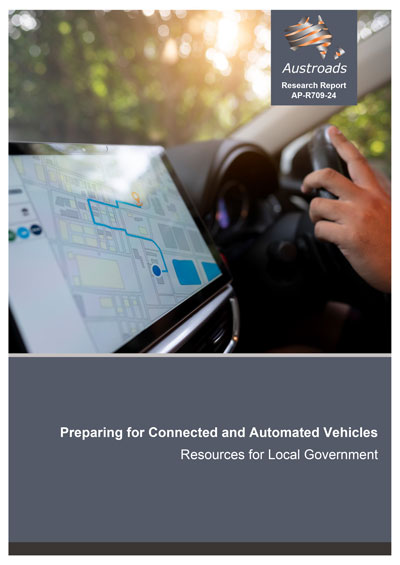Connected and Automated Vehicles

- Publication no: AP-R709-24
- ISBN: 978-1-922994-35-6
- Published: 20 June 2024
- PDF (free) Download
This report provides guidance to local governments (LGs) in Australia and New Zealand to enhance their preparedness for connected and automated vehicles (CAVs). Drawing insights from a range of research sources, it identifies ten critical areas essential for LGs to effectively prepare for CAV integration. These areas span legal considerations and infrastructure readiness to financial impacts and stakeholder engagement. The report identifies actions to support current and near-term vehicles with human operators and longer-term, fully automated vehicles. This provides flexibility for LGs to adapt to varying rates of CAV market adoption.
Included in this report are two tools: the LG CAV Preparedness Framework and Inflection Point Monitoring. The Framework offers a structured approach, detailing three levels of LG preparedness and corresponding actions expected at each stage. It serves as a tool for assessment, aiding LGs in evaluating their readiness and planning their course of action. Inflection Point Monitoring helps LGs identify crucial moments in CAV market development and adoption, enabling them to track CAV-related indicators and make informed decisions on timing and strategy.
The report emphasises the significance of collaboration amongst LGs, other governments, and industry stakeholders for successful CAV implementation. It suggests specific resources to be developed to assist LGs in their preparation, such as an online information hub, market penetration reports, educational material, safety guidelines, and digital infrastructure support. This will help foster an integrated approach to support CAVs within the transport system.
Watch a webinar with David Yee and Andrew Somers designed to help people working in local government across Australia and New Zealand to navigate the evolving landscape of connected and automated vehicles.
- Summary
- 1. Introduction
- 1.1 Purpose
- 1.2 Scope
- 1.3 Methodology
- 1.4 Key Terms
- 2. LG CAV Support Actions
- 2.1 Legal Considerations
- 2.2 Land Use and Transport Planning
- 2.3 Physical Infrastructure Readiness
- 2.4 Digital Infrastructure Readiness
- 2.5 Road Safety
- 2.6 Managing Traffic Movements
- 2.7 Financial Impacts
- 2.8 Environmental and Socio-economic Impacts
- 2.9 Stakeholder and Community Readiness
- 2.10 Capability Building
- 3. Decision-Making Tools
- 3.1 LG CAV Preparedness Framework
- 3.2 Inflection Point Monitoring
- 4. LG CAV Support Action Guidance
- 4.1 Identify Agency’s Current State of CAV Support Preparedness
- 4.2 Determine Agency’s Target State of CAV Support Preparedness
- 4.3 Perform Gap Analysis and Identify CAV Support Actions
- 4.4 Prioritise Actions
- 4.5 Develop the CAV Support Action Roadmap
- 4.6 Plan and Deliver Actions
- 5. Supporting Actions and Engagement with State, Territory and National Governments, and Industry
- 6. Conclusions
- References
- Appendix A Research Findings
- A.1 Australian and New Zealand Research
- A.1.1 NSW
- A.1.2 Victoria
- A.1.3 Queensland
- A.1.4 Western Australia
- A.1.5 South Australia
- A.1.6 Australian Commonwealth Government
- A.1.7 New Zealand Mininstry of Transport
- A.1.8 Austroads
- A.2 International Research
- A.2.1 Polis: Road Vehicle Automation and Cities and Regions (Europe)
- A.2.2 CoEXist (Europe)
- A.2.3 TRB NCHRP Project 20-113F: Preparing for AVs and Shared Mobility (USA)
- A.2.4 TAC - Developing Highly Qualified Personnel for an Era of Connected and Automated Vehicles
- A.2.5 Ministry of Transportation of Ontario CAV Readiness Plan (Canada)
- A.2.6 Automated and Connected Vehicles Policy Framework for Canada
- A.2.7 MetroPlan Orlando CAV Readiness Study (USA)
- A.2.8 Virginia DOT CAV Program Plan (USA)
- A.2.9 TRB – Strategies to Advance Automated and Connected Vehicles
- A.2.10 US DOT - Preparing for the Future of Transportation: Automated Vehicles 3.0
- A.2.11 US DOT Automated Vehicles Comprehensive Plan
- A.2.12 APA – Preparing Communities for Autonomous Vehicles
- A.2.13 Austin City Council – smart mobility roadmap
- A.2.14 National League of Cities – Autonomous Vehicles: A Policy Preparation Guide
- A.2.15 National Association of Counties (NACo) Connected and Automated Vehicles Toolkit: A Primer for
- Counties
- A.2.16 FHWA – Roadway Automation Driving System Integration – Concept of Operations for Transportation
- Agencies
- A.2.17 FHWA - Impacts of Automated Vehicles on Highway Infrastructure
- A.2.18 AMPO National Framework for Regional Vehicle Connectivity and Automation Planning
- A.2.19 IET UK - Expect the Unexpected
- A.2.20 OECD ITF – Preparing Infrastructure for Automated Vehicles
- A.2.21 US DOT Transportation Planning Capacity Building
- A.2.22 MnDOT Planning for Automated Vehicles: How to Plan for an Unknown Future
- A.2.23 Potential Portfolio for EU-US Research on Socioeconomic Impacts of CAVs
- A.1 Australian and New Zealand Research
